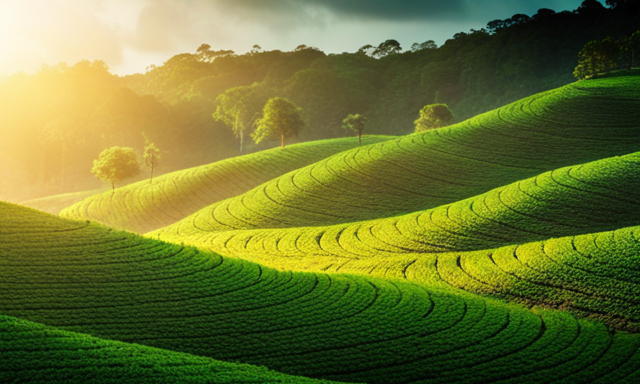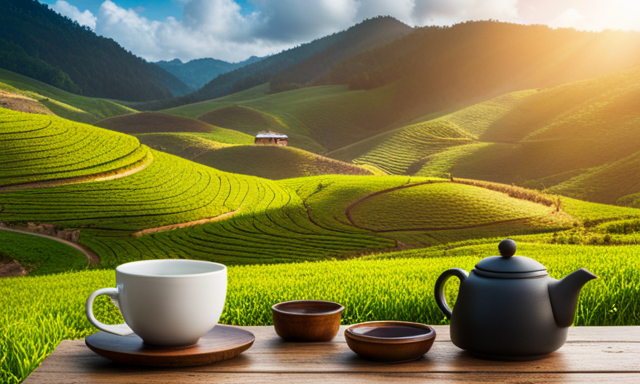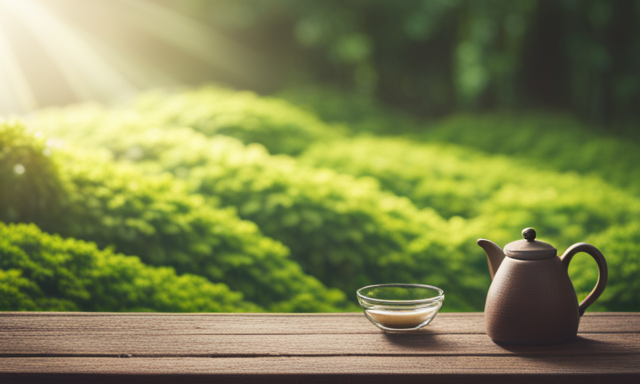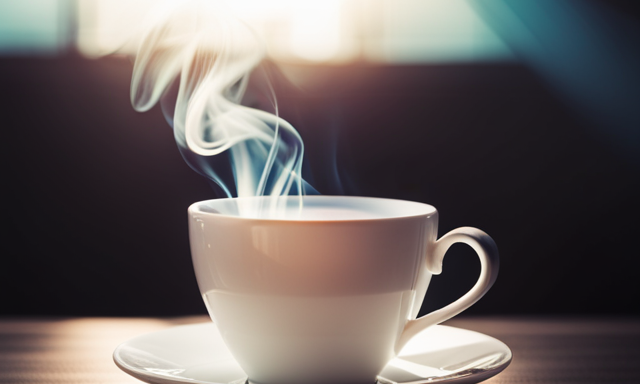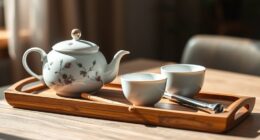I love oolong tea. Its intricate flavors and subtle scents set it apart as one of the finest teas available. If you’ve ever wondered about the ideal climate for growing oolong tea, you’re in for a treat! This article will take you on a journey through the captivating realm of oolong tea cultivation.
As a tea enthusiast, I have delved into the origins and history of oolong tea, discovering its rich heritage and cultural significance. I have also studied the climate requirements for growing this marvelous tea, understanding the importance of temperature, humidity, and sunlight. With this knowledge, I will help you choose the right oolong tea varieties for your specific climate.
But it doesn’t stop there. I will share expert tips on preparing the soil, planting the tea, and caring for the plants throughout the seasons. We will also explore the art of tea tasting, learn about different flavor profiles, and discover the best ways to store and age oolong tea for maximum enjoyment.
So, join me on this journey as we uncover the secrets of oolong tea cultivation and brewing. Get ready to sip and savor the perfect cup of oolong tea!
Key Takeaways
- Oolong tea requires specific climate conditions for cultivation, including temperatures between 15-30°C (59-86°F), 4-6 hours of direct sunlight per day, 120-200 cm (47-79 inches) of rainfall per year, and humidity levels of 60-70%.
- Different oolong tea varieties have different climate preferences, with some preferring cooler climates and others preferring warmer temperatures.
- Oolong tea plants thrive in well-drained soil with a pH between 6 and 7.5, preferably sandy loam or loamy soil.
- Proper care for oolong tea plants includes digging a hole twice as wide and deep as the root ball for planting, pruning to maintain plant health and productivity, shaping for better light exposure, fertilizing every 4-6 weeks, deep watering while avoiding waterlogging, and allowing the soil to slightly dry out between waterings.
The Origins and History of Oolong Tea
Oolong tea, with its rich and fascinating history, traces its roots back to the misty mountains of China. The origins of this unique tea can be traced back to the early 18th century, during the Qing dynasty.
Oolong tea holds great cultural significance in Chinese tradition and is often associated with ceremonies and special occasions. The tea is made from the leaves of the Camellia sinensis plant, which are partially oxidized before being dried and processed. This partial oxidation gives oolong tea its distinctive flavor and aroma.
Understanding the climate requirements for oolong tea cultivation is crucial for successful growth. The tea thrives in areas with cool temperatures, high humidity, and ample rainfall. These specific climatic conditions contribute to the unique taste and quality of oolong tea.
Understanding the Climate Requirements for Oolong Tea Cultivation
Ironically enough, the success of cultivating this delightful beverage heavily relies on the specific weather conditions it thrives in. When it comes to oolong tea, climate considerations are of utmost importance. Here are three essential factors to keep in mind when growing this beloved tea:
-
Temperature: Oolong tea plants prefer a moderate climate, with temperatures ranging between 15-30°C (59-86°F). Extreme heat or cold can hinder the plant’s growth and affect the flavor of the leaves.
-
Sunlight: Oolong tea plants require ample sunlight to thrive. They prefer partial shade, where they receive around 4-6 hours of direct sunlight per day. Too much shade can result in weak growth and poor tea quality.
-
Rainfall and Humidity: Oolong tea plants need a balanced water supply. They thrive in areas with moderate rainfall, around 120-200 cm (47-79 inches) per year. Additionally, the humidity should be around 60-70% to create the ideal growing environment.
Understanding these climate considerations and implementing suitable growing techniques will ensure the successful cultivation of oolong tea. Now, let’s delve into choosing the right varieties for your climate.
Choosing the Right Varieties for Your Climate
To ensure the successful cultivation of oolong tea in your specific environment, you’ll want to carefully select the right tea varieties that are best suited to your climate. Different oolong tea varieties have varying growing conditions and climate adaptations.
Some varieties thrive in cooler climates, while others prefer warmer temperatures. It is important to consider factors such as temperature range, humidity levels, and rainfall patterns when choosing the appropriate variety for your region.
For cooler climates, you may want to opt for hardier varieties that can withstand lower temperatures, while in warmer climates, you can select varieties that are more heat-tolerant. By selecting the right tea varieties that are well-adapted to your climate, you can maximize the chances of a successful oolong tea harvest.
In the subsequent section about preparing the soil and planting oolong tea, we will delve into the necessary steps for getting your tea plants off to a healthy start.
Preparing the Soil and Planting Oolong Tea
Get your hands dirty and start preparing the soil for planting your oolong tea. This will create a fertile foundation for your tea plants to thrive.
The first step in preparing the soil is to assess its composition. Oolong tea plants prefer a well-drained soil with a pH level between 6 and 7.5. Sandy loam or loamy soil is ideal as it provides good drainage while retaining some moisture. If your soil is too clayey, you can improve its drainage by adding organic matter such as compost or well-rotted manure.
Once the soil composition is suitable, it’s time to plant your oolong tea. Dig a hole that is twice as wide and deep as the root ball of the plant. Place the plant in the hole, backfill with soil, and gently firm it around the roots.
Now you’re ready to move on to caring for oolong tea plants throughout the seasons, ensuring their healthy growth and bountiful harvest.
Caring for Oolong Tea Plants Throughout the Seasons
When it comes to caring for Oolong tea plants throughout the seasons, there are three key points to keep in mind.
The first is pruning and shaping, which is essential for promoting healthy growth and maintaining the desired shape of the plant.
The second is fertilizing and watering, which are crucial for providing the necessary nutrients and moisture for optimal growth.
Lastly, pest and disease control is important to protect the plants from potential threats that could hinder their development.
Pruning and Shaping
Pruning and shaping help create the ideal conditions for climate oolong tea to thrive and flourish. Proper pruning techniques and shaping methods are essential for maintaining the health and productivity of oolong tea plants throughout the seasons. When it comes to pruning, it is important to remove any dead or diseased branches, as well as any overcrowded growth that can hinder air circulation and sunlight penetration. Shaping the plants can be done through selective pruning to encourage lateral growth and maintain an open canopy. This allows for better light exposure and airflow, which are crucial for the optimal development of tea leaves. By practicing these techniques, we can ensure that our oolong tea plants are well-maintained and ready to receive the necessary fertilizing and watering they require for maximum growth and flavor.
Fertilizing and Watering
To make your plants thrive and flourish, you’ll want to ensure they receive the right nutrients and hydration. Fertilizing techniques play a crucial role in the growth of oolong tea plants. It’s recommended to use a balanced, slow-release fertilizer that contains equal amounts of nitrogen, phosphorus, and potassium. Apply the fertilizer during the growing season, starting in early spring and continuing every four to six weeks. Be careful not to over-fertilize, as this can lead to excessive leaf growth and a decrease in flavor.
As for watering, oolong tea plants require a consistent and well-drained watering schedule. They prefer moist soil, so water them deeply but avoid waterlogging. Allow the soil to dry out slightly between waterings.
By following these fertilizing and watering practices, you can ensure your oolong tea plants stay healthy and productive. Moving on to pest and disease control, it’s important to be proactive and take preventive measures.
Pest and Disease Control
After ensuring proper fertilization and watering techniques, it’s imperative to address the issue of pest and disease control in order to successfully grow climate oolong tea. Effective pest control measures are essential to protect the tea plants from harmful insects such as aphids and mites, which can cause significant damage to the leaves and hinder growth.
Additionally, disease prevention is crucial to maintain the health and vitality of the plants. This can be achieved through the use of organic fungicides and regular monitoring for signs of diseases like blight or root rot.
Implementing a comprehensive pest control and disease prevention strategy will help safeguard the tea plants and promote optimal growth.
Now that we have established these essential practices, let’s delve into the next crucial stage: harvesting and processing oolong tea leaves.
Harvesting and Processing Oolong Tea Leaves
During the tea harvest, skilled farmers carefully pluck the finest oolong leaves, treating each one like a precious gem. Harvesting techniques play a crucial role in determining the quality of the tea.
The leaves are typically plucked when they reach a specific maturity level, which varies depending on the specific oolong variety and desired flavor profile. The plucking process involves selecting only the young, tender leaves and avoiding any damaged or discolored ones.
After harvesting, the leaves undergo a process known as tea leaf oxidation. This step is essential in oolong tea production as it allows the leaves to develop their unique flavors and aromas. The oxidation process is carefully controlled to ensure the desired level of fermentation is achieved.
Once the leaves are oxidized, they are then gently heat-treated to halt the oxidation process. This step not only preserves the flavors but also helps shape the tea’s final characteristics.
As the tea leaves undergo these intricate processes, they gradually transform, showcasing the art of tea tasting and flavor profiles.
The Art of Tea Tasting and Flavor Profiles
Tea tasting is a sensory experience that allows connoisseurs to explore the intricate flavor profiles of different varieties. When it comes to oolong tea, the range of flavors is vast and diverse. To fully appreciate and understand these flavors, it’s important to use proper tea tasting techniques. This involves using a small porcelain cup and paying attention to the tea’s aroma, appearance, and taste.
The first step is to gently inhale the aroma of the dry leaves, allowing the scent to linger and evoke a sense of anticipation. Next, observe the tea’s color and clarity, noting any variations and nuances. Finally, take small sips of the tea, allowing it to coat your palate and savor the complex flavors. By exploring different oolong tea flavors, you can develop a discerning palate and appreciate the subtleties of each variety.
Transitioning into the subsequent section about storing and aging oolong tea, it’s important to consider the impact of time on the flavor profile.
Storing and Aging Oolong Tea
To fully appreciate the flavors of oolong tea, you’ll want to know how to properly store and age it. Storing tea leaves in the right conditions is crucial to preserving its quality and flavor.
The main enemies of tea storage are heat, light, moisture, and strong odors. To protect your oolong tea, store it in a cool, dry place, away from direct sunlight and strong smells. Consider using airtight containers to prevent moisture and air exposure.
Aging tea can enhance its flavors by allowing the chemical compounds to interact and mellow over time. Oolong tea can be aged for several years, and during this process, the flavors become smoother and more complex.
Aging tea flavors can be a fascinating journey of exploration and appreciation. Now, let’s delve into the sustainability and environmental considerations in oolong tea production.
Sustainability and Environmental Considerations in Oolong Tea Production
Did you know that considering sustainability and environmental factors in the production of oolong tea can have a significant impact on its quality and taste? Sustainable farming practices and conducting environmental impact assessments are crucial steps in ensuring that oolong tea production is not only environmentally friendly but also maintains the integrity of the tea. By implementing sustainable farming practices such as organic cultivation, water conservation, and soil management, tea farmers can minimize the use of harmful pesticides and preserve the natural ecosystem. Additionally, conducting environmental impact assessments allows producers to identify potential risks and develop strategies to mitigate them. This holistic approach to oolong tea production not only benefits the environment but also ensures that the tea you enjoy is of the highest quality. Speaking of quality, let’s move on to the next section and explore some tips for brewing the perfect cup of oolong tea.
Tips for Brewing the Perfect Cup of Oolong Tea
Now that we’ve discussed the importance of sustainability and environmental considerations in oolong tea production, let’s dive into the art of brewing the perfect cup of oolong tea.
As a tea enthusiast, I understand the significance of using the right brewing techniques to bring out the full flavor and aroma of this delicate tea. Oolong tea requires a careful balance of temperature and steeping time to unlock its complex flavors.
The ideal water temperature for brewing oolong tea is around 180-200°F (82-93°C). Steeping times can vary depending on the type of oolong tea, but generally range from 2-5 minutes. It’s crucial to experiment with different steeping times to find your preferred strength and taste.
Remember, oolong tea leaves can be steeped multiple times, so don’t hesitate to enjoy multiple infusions from a single batch.
With these brewing tips, you can savor the rich and nuanced flavors of oolong tea with every sip.
Frequently Asked Questions
What are the health benefits of drinking oolong tea?
Drinking oolong tea offers numerous health benefits, including aiding weight loss. Its rich antioxidants help boost metabolism and burn fat. Sip on this delightful brew to enjoy a healthier lifestyle.
Can oolong tea be grown indoors?
Yes, oolong tea can be successfully cultivated indoors. To ensure optimal growth, choose oolong tea varieties that are well-suited for indoor conditions. Providing the right temperature, humidity, and light levels is crucial for successful indoor oolong tea cultivation.
How long does it take for oolong tea plants to mature and start producing leaves?
Oolong tea plants typically take about 3 years to mature and start producing leaves. Once mature, they can be harvested by plucking the top two leaves and a bud, which is then processed through withering, rolling, oxidation, and drying.
What are the common pests and diseases that affect oolong tea plants?
Common pests and diseases that affect oolong tea plants include aphids, mites, leafhoppers, tea green leafhoppers, and root rot. These pests and diseases can significantly impact the health and productivity of the plants if not properly managed.
Are there any specific pruning techniques for oolong tea plants?
Pruning techniques for oolong tea plants involve removing old and weak branches to promote new growth. It’s important to consider growth factors such as sunlight, soil fertility, and proper spacing to ensure optimal plant development.
Conclusion
In conclusion, the process of growing oolong tea is an intricate and fascinating journey. From understanding the climate requirements to selecting the right varieties, preparing the soil, and caring for the plants, every step is crucial for producing the perfect cup of tea.
The art of tea tasting and flavor profiles adds depth to the experience, while storing and aging oolong tea enhances its unique characteristics. Additionally, sustainability and environmental considerations play a crucial role in oolong tea production.
So, if you’re ready to embark on this scientific and detailed adventure, get ready to savor the suspenseful rewards of growing your own oolong tea.

